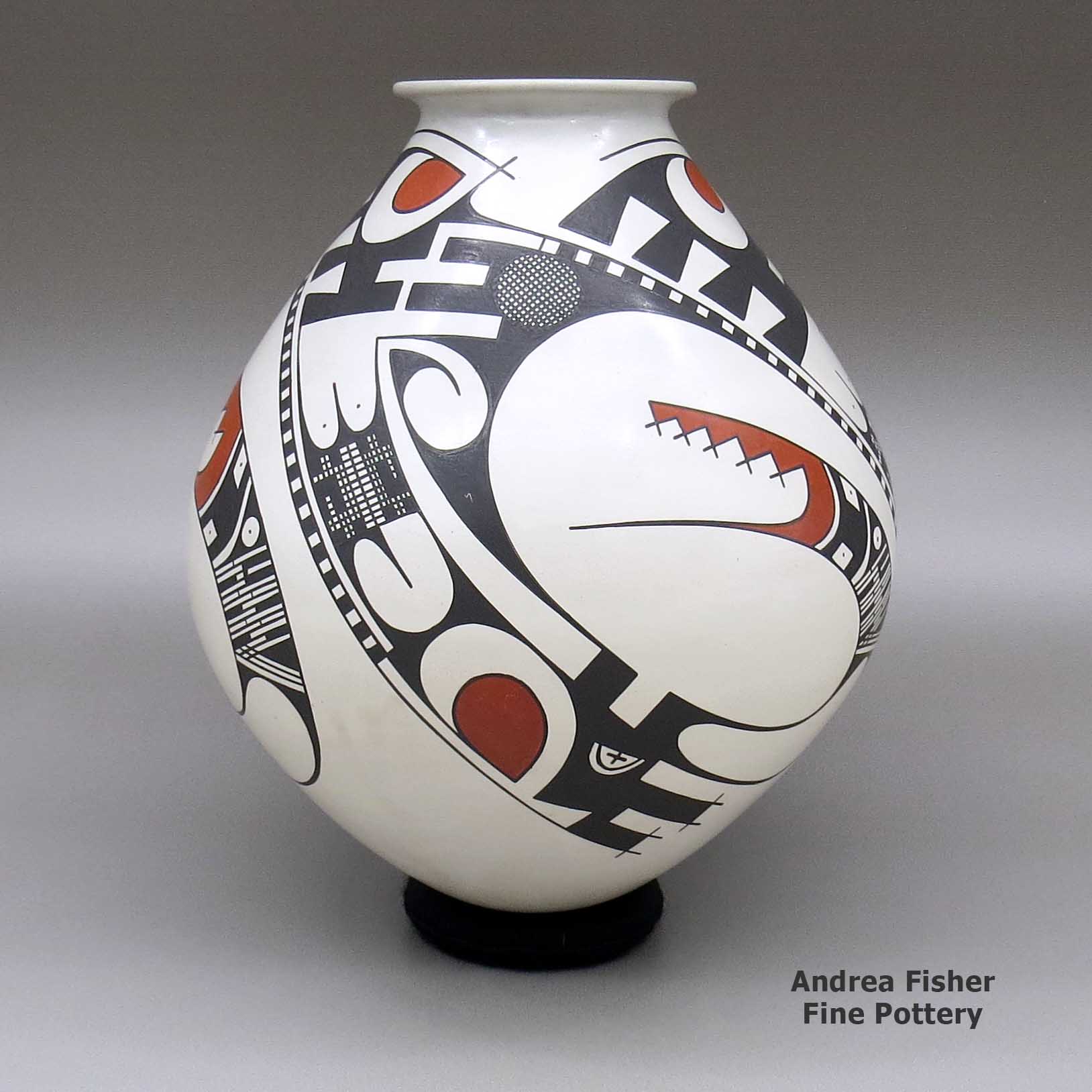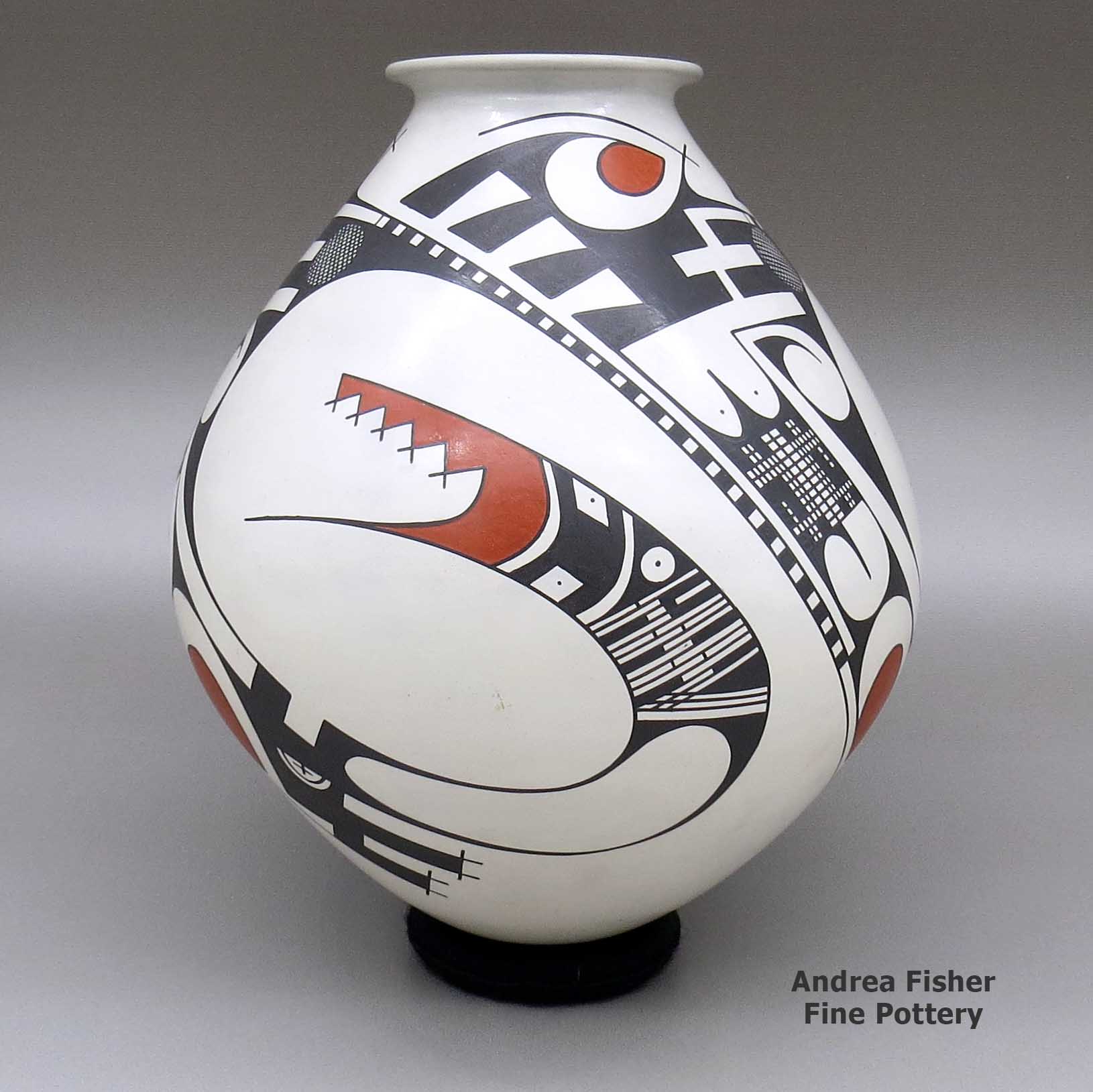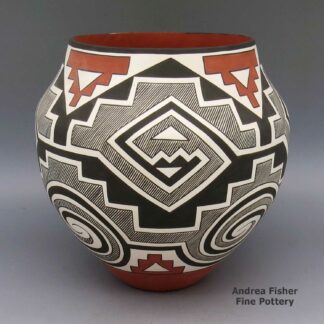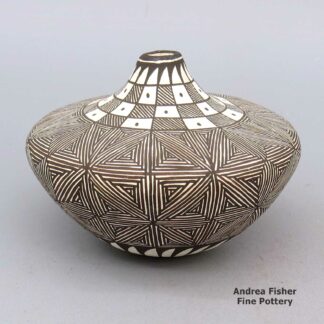| Dimensions | 8.5 × 8.5 × 10.75 in |
|---|---|
| Measurement | Measurement includes stand |
| Condition of Piece | Very good, normal wear |
| Signature | Juan Quezada |
Juan Quezada Sr, thcg3b017, Jar with geometric design
$3,900.00
A polychrome jar with a rolled lip and decorated with a Paquime Revival serpent and geometric design
In stock
- Product Info
- About the Artist
- Home Village
- Design Source
- About the Shape
- About the Design
- Family Tree
Brand
Quezada, Juan Sr
 In many respects, the Paquimé Revival pottery of Mata Ortiz owes its birth to Juan Quezada Sr. As a young man, Juan was trying to get by as a farmer, cowherd and supplier of firewood in the vicinity of the village of Mata Ortiz. Each of these activities brought him into the ruins of what were formerly outlying villages and rancherias of the major pueblos of Paquimé and Casas Grandes.
In many respects, the Paquimé Revival pottery of Mata Ortiz owes its birth to Juan Quezada Sr. As a young man, Juan was trying to get by as a farmer, cowherd and supplier of firewood in the vicinity of the village of Mata Ortiz. Each of these activities brought him into the ruins of what were formerly outlying villages and rancherias of the major pueblos of Paquimé and Casas Grandes.By the time Spanish explorers reached the region in the early 1500s, Paquimé had been abandoned for a hundred years and was washing away more with each succeeding rainfall. However, the ruins impressed the Spanish as an example of a formerly wealthy New World community and perhaps spurred them on to find out where the gold went.
These days, the ruins of Paquimé are a designated United Nations World Heritage site. Much of the area has been excavated and a significant portion of the ruins have been stabilized so that erosion doesn't have quite the effect it used to. That said, in some areas there are still ancient potsherds scattered all over the ground. To dig a few inches down is to expose many more.
There were also many unbroken pots unearthed in the area, pots showing a multitude of designs, shapes, forms and uses. Some of the designs and forms found have been traced back to the Mimbres culture of southern New Mexico and to possible Hohokam influences. Many of the Mimbres designs are still in use by potters across the Southwest Pueblo world.
Archaeologists have suggested that when the Mimbres people abandoned the Mimbres Valley in southern New Mexico around 1250 CE, some went north to the Acoma and Laguna areas and some went south to the area of Paquimé. The area of Paquimé may have been wetter in those days but by about 1400, it was getting pretty dry. Paquimé was completely abandoned by 1450 CE.
Juan Quezada Sr. often found himself wandering through the ruins of outlying villages, stepping on potsherds everywhere he went. Eventually he started picking them up and examining them. Then he stumbled across a cave that contained unbroken pots painted by the residents of Paquimé hundreds of years ago. That led to him trying to figure out how the pots were first made, then where the colors came from and how the designs fit together. With no tools to work with outside of his own drive to discover and his own ingenuity, it supposedly took him several years to figure it out.
Juan's creations may have gone unnoticed except for the serendipitous discovery of a few of his pieces in a small shop in Deming, New Mexico by an Anglo trader named Spencer MacCallum. Spencer recognized quality when he saw it but it took him a while to follow the trail back to Juan. Once he'd met Juan, Spencer came up with a great marketing story and out of that marketing story grew the brilliance that is today's Mata Ortiz pottery. And as good a potter as Juan was, that marketing story was not a true story. It did serve to make Juan famous in the United States but in Mexico, he's almost unknown.
Juan had an exclusive contract with Spencer MacCallum for three years. By 1979 when the contract ended, there was a lot of friction around it, between Spencer and Juan and between Juan and other potters in Mata Ortiz. The marketing story started to unravel in the 1980s but it's still being repeated in many places.
The meeting with Spencer MacCallum fueled Juan's rise and as his pieces brought more and more income, his siblings got more and more interested in making pottery. Before long, Juan had taught them all how to do it and over the years since, many other potters have learned, made it their own and built their own careers. Many Mata Ortiz residents make and sell pottery into the United States and global markets and bring a level of prosperity to Mata Ortiz that the village has never known.
Juan is also the progenitor of the Quezada style, a design style that incorporates blank space into the overall design.
In contradistinction to that is the Porvenir style, originated by potters in the Porvenir neighborhood of Mata Ortiz. The Porvenir style essentially decorates every centimeter of a pot's surface, leaving little-to-no blank space.
Juan retired and lived his last years on a ranch atop one of the hills above Mata Ortiz. He didn't make much pottery any more but he did work with younger folks, teaching them the basics and some of his more advanced techniques. A lot of folks in Mata Ortiz owe their prosperity to Juan's willingness to teach and pass on his knowledge and techniques. The Government of Mexico honored Juan by giving him the Premio Nacional de los Artes, the highest honor Mexico gives to its finest living artists. Sadly, Juan died at his ranch in December, 2022.
About Mata Ortiz and Casas Grandes
Mata Ortiz is a small settlement inside the bounds of the Casas Grandes municipality, very near the site of Paquimé. The fortunes of the town have gone up and down over the years with a real economic slump happening after the local railroad repair yard was relocated to Nuevo Casas Grandes in the early 1960s. It was a village with a past and little future.
A problem around the ancient sites has been the looting of ancient pottery. From the 1950s on, someone could dig up an old pot, clean it up a bit and sell it to an American dealer (and those were everywhere) for more money than they'd make in a month with a regular job. And there's always been a shortage of regular jobs.
Many of the earliest potters in Mata Ortiz began learning to make pots when it started getting harder to find true ancient pots. So their first experiments turned out crude pottery but with a little work, their pots could be "antiqued" enough to pass muster as being ancient. Over a few years each modern potter got better and better until finally, their work could hardly be distinguished from the truly ancient. Then the Mexican Antiquities Act was passed and terror struck: because the old and the new could not be differentiated, potters were having all their property seized and their families put out of their homes because of "antiqued" pottery they made just yesterday. Things had to change almost overnight and several potters destroyed large amounts of their own inventory because it looked "antique." Then they went about rebooting the process and the product in Mata Ortiz.
For more info:
Mata Ortiz pottery at Wikipedia
Mata Ortiz at Wikipedia
Casas Grandes at Wikipedia
About the Prehistoric City of Paquimé
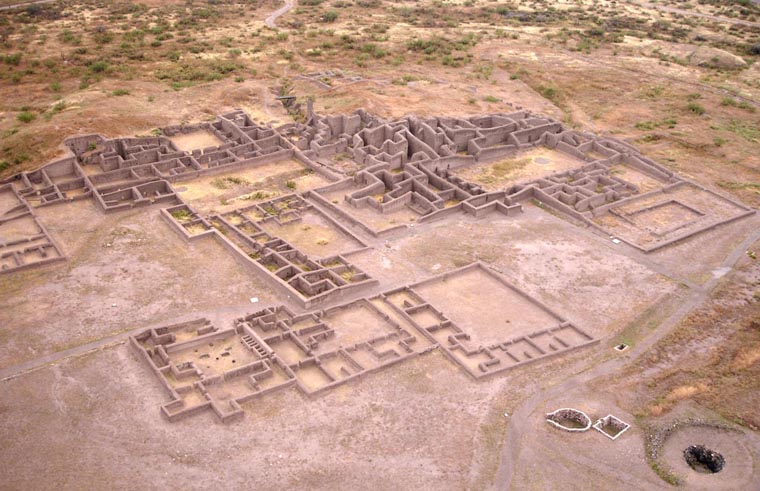
Paquimé was a major center of society, religion, trade and the arts from around 1150 CE to about 1450 CE, when the city was abandoned. When the first Spanish explorer came across the ruins he didn't know what he was looking at as the city was several stories in height and covered a lot of land. But there was no one living there any more.
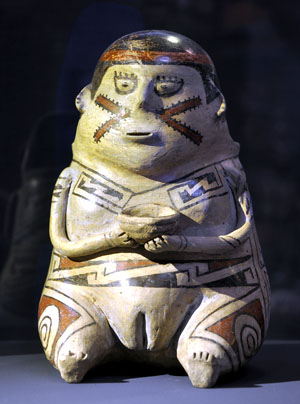
Archaeologists don't know where the first residents came from but there was a major in-migration to the area in the mid-1100s from the north as the Mimbres Valley was being depopulated and people were moving cross-country. That century of the 1100s was unstable with volcanic ash in the air globally and bad weather event after bad weather event happening.
Paquimé is almost squarely in the center of the Mogollon culture back then, the Mimbres Valley was a northern branch. Paquimé was a crossroads with trade routes carrying turquoise south and birds, copper bells and rituals north.
A lot has been made of the many macaw pens found at Paquimé but little mention of the green parrots. Macaws were trafficked to be used as sacrificial offerings to the sun around the time of the Winter Solstice. We don't know what green parrots were for but their remains have been found in only three places north of the jungles where they normally live: Paquimé, Cicuyé (aka Pecos) and Grasshopper Pueblo (a ruin in east-central Arizona).
Archaeologists following the Turquoise Trail found that many threads of that trail passed through Paquimé headed to different destinations in the south. Returns from the south seem to have been sorted at Paquimé and then sent to their destinations in the north.
Paquimé was a melting pot with inputs coming from the Mayans and the Aztecs meeting inputs from the local area and inputs from the north. When the Mimbres Valley was being depopulated, suddenly their pottery designs were popping up at Paquimé. At Paquimé those ideas and designs were developed further. It helped, too, that multiple colors of clay were easily available around the city: there was an explosion of polychrome pottery and figures.
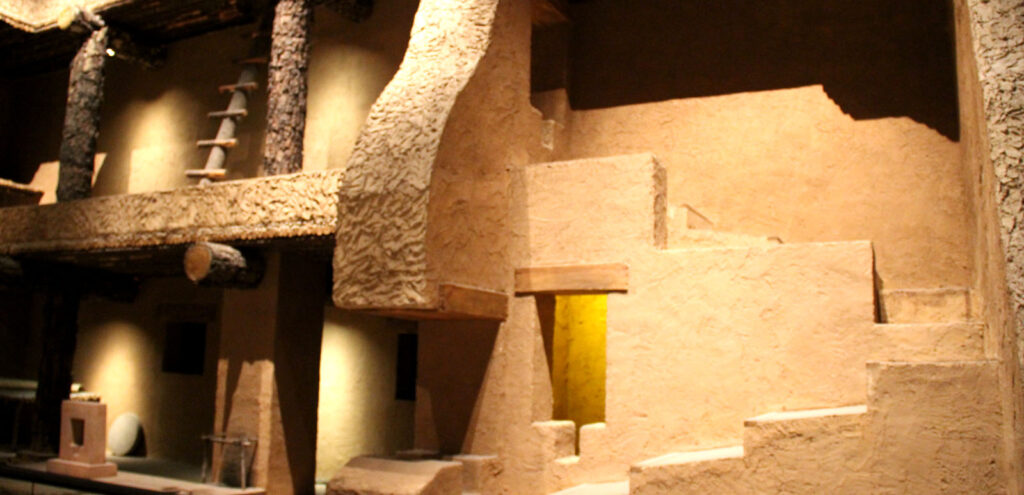

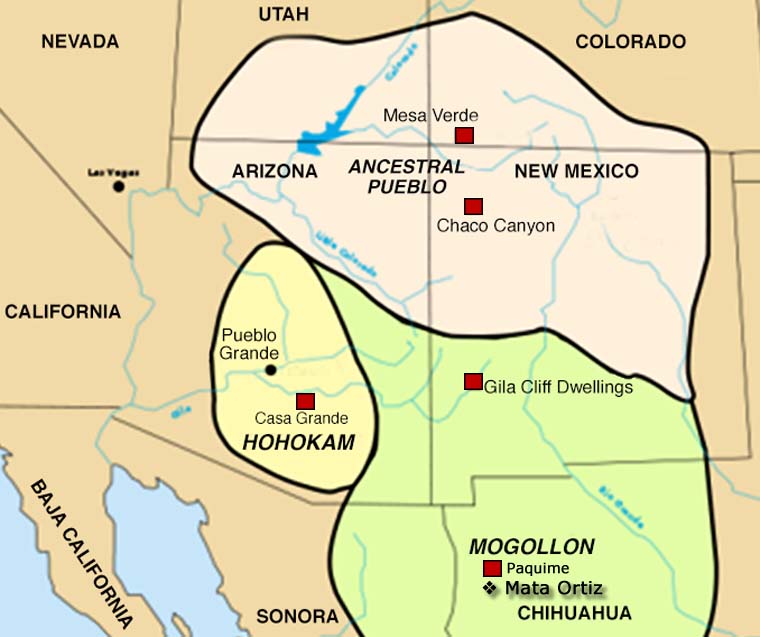
About Jars
The jar is a basic utilitarian shape, a container generally for cooking food, storing grain or for carrying and storing water. The jar's outer surface is a canvas where potters have been expressing their religious visions and stories for centuries.
In Sinagua pueblos (in northern Arizona), the people made very large jars and buried them up to their openings in the floors of the hidden-most rooms in their pueblo. They kept those jars filled with water but also kept smaller jars of meat and other perishables inside those jars in the water. It's a form of refrigeration still in use among indigenous people around the world.
Where bowls tend to be low, wide and with large openings, jars tend to be more globular: taller, less wide and with smaller openings.
For a potter looking at decorating her piece, bowls are often decorated inside and out while most jars are decorated only on the outside. Jars have a natural continuity to their design surface where bowls have a natural break at the rim, effectively yielding two design surfaces on which separate or complimentary stories can be told.
Before the mid-1800s, storage jars tended to be quite large. Cooking jars and water jars varied in size depending on how many people they were designed to serve. Then came American traders with enameled metal cookware, ceramic dishes and metal eating utensils...Some pueblos embraced those traders immediately while others took several generations to let them and their innovations in. Either way, opening those doors led to the virtual collapse of utilitarian pottery-making in most pueblos by the early 1900s.
In the 1920s there was a marked shift away from the machinations of individual traders and more toward marketing Native American pottery as an artform. Maria Martinez was becoming known through her exhibitions at various major industrial fairs around the country and Nampeyo of Hano was demonstrating her art for the Fred Harvey Company at the Grand Canyon. The first few years of the Santa Fe Indian Market helped to solidify that movement and propel it forward. It took another couple generations of artists to open other venues for their art across the country and turn Native American art into the phenomenon it has become.
Today's jars are artwork, not at all for utilitarian purposes, and their shapes, sizes and decorations have evolved to reflect that shift.
About Geometric Designs
"Geometric design" is a catch-all term. Yes, we use it to denote some kind of geometric design but that can include everything from symbols, icons and designs from ancient rock art to lace and calico patterns imported by early European pioneers to geometric patterns from digital computer art. In some pueblos, the symbols and patterns denoting mountains, forest, wildlife, birds and other elements sometimes look more like computer art that has little-to-no resemblance to what we have been told they symbolize. Some are built-up layers of patterns, too, each with its own meaning.
"Checkerboard" is a geometric design but a simple black-and-white checkerboard can be interpreted as clouds or stars in the sky, a stormy night, falling rain or snow, corn in the field, kernels of corn on the cob and a host of other things. It all depends on the context it is used in, and it can have several meanings in that context at the same time. Depending on how the colored squares are filled in, various basket weave patterns can easily be made, too.
"Cuadrillos" is a term from Mata Ortiz. It denotes a checkerboard-like design using tiny squares filled in with paints to construct larger patterns.
"Kiva step" is a stepped geometric design pattern denoting a path into the spiritual dimension of the kiva. "Spiral mesa" is a similar pattern, although easily interpreted with other meanings, too. The Dineh have a similar "cloud terrace" pattern.
That said, "geometric designs" proliferated on Puebloan pottery after the Spanish, Mexican and American settlers arrived with their European-made (or influenced) fabrics and ceramics. The newcomers' dinner dishes and printed fabrics contributed much material to the pueblo potters design palette, so much and for so long that many of those imported designs and patterns are considered "traditional" now.
Juan Quezada Family and Teaching Tree - Mata Ortiz
Disclaimer: This "family and teaching tree" is a best effort on our part to determine who the potters are in this grouping and arrange them in a generational order/order of influence. Complicating this for Mata Ortiz is that everyone essentially teaches everyone else (including the neighbors), so it's hard to get a real lineage of family/teaching. The general information available is scant. This diagram is subject to change as we get better info.
- Juan Quezada Sr. (1940-2022) & Guillermina Olivas Reyes (1945-)
- Nicolas Quezada (1947-2011) & Maria Gloria Orozco
- Elida Quezada & Ramon Lopez
- Jose Quezada (1972-) & Marcela Herrera
- Leonel Quezada Talamontes (1977-2014)
- Reynaldo Quezada & Monserat Treviso
- Lucia Quezada
- Lupita Quezada & Hector Quintana
- Maria de los Angeles Quezada
- Maria Guadalupe Quezada
- Mariano Quezada Treviso & Rocio de Quezada
- Maria Acosta
- Fernando Andrew
- Octavio Andrew (1970-)
- Jose Cota
- Gloria Lopez
- Rosa Lopez
Rosa and Gloria's students:
- Roberto & Angela Banuelos
- Adriana Banuelos
- Diana Laura Banuelos
- Mauricio Banuelos
- Olga Quezada & Humberto Ledezma
- Roberto & Angela Banuelos
- Lydia Quezada & Rito Talavera
- Moroni Quezada (1993-)
- Pabla Quezada
- Consolacion Quezada & Guadalupe Corona Sr.
- Dora Quezada
- Guadalupe Lupe Corona Jr.
- Hilario Quezada Sr. & Matilde Olivas de Quezada
- Mauro Quezada (1968-) & Martha Martinez de Quezada
- Avelina Corona & Angel Amaya
- Mauro Corona
- Luis Baca & Carmen Fierro
- Avelina Corona & Angel Amaya
- Oscar Corona Quezada
- Octavio Gonzalez Camacho (Quezada)
- Oscar Gonzales Quezada Jr.
- Guadalupe Lupita Cota
- Reynalda Quezada & Simon Lopez
- Samuel Lopez Quezada (1972-) & Estella S. de Lopez
- Olivia Lopez Quezada & Hector Ortega
- Yolanda Lopez Quezada
- Rosa Quezada
- Noelia Hernandez Quezada (1975-)
- Paty Quezada
- Jesus Quezada
- Imelda Quezada
- Jaime Quezada
- Jose Luis Quezada Camacho
- Mary Quezada
- Genoveva Quezada & Damian Escarcega
- Damian Quezada & Elvira Antillon
- Anjelica Escarcega
- Ana Trillo
- Yesenia Escarcega
- Ivona Quezada
- Miguel Quezada
- Damian Quezada & Elvira Antillon
- Alvaro Quezada
- Arturo Quezada
- Efren Quezada
- Juan Quezada Jr. & Lourdes Luli Quintana de Quezada
- Laura Quezada
- Maria Elena Nena Quezada de Lujan
- Alondra Lujan Quezada
- Mireya Quezada
- Noe Quezada & Betty Quintana de Quezada
- Guillermina Quezada Quintana
- Ivan Quezada Quintana
- Lupita Quezada Quintana
- Taurina Baca (1961-)
- Gerardo Cota
- Guadalupe Gallegos
- Ivonne Olivas
- Manuel Manolo Rodriguez Guillen (1972-)

